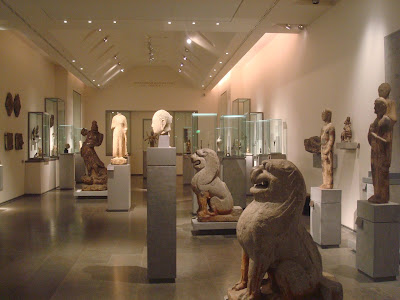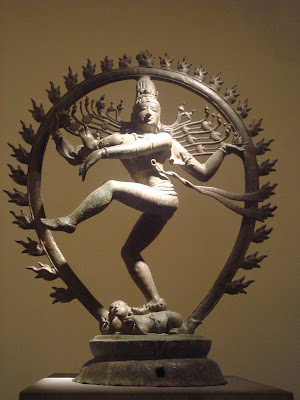Happy New Year's, everyone!!!
Now back to your regular programming ----------------------------------------------------
It was toss up between heading out to Monet's Garden in Giverny (an hour or so by train+bus) or taking it slightly easier and visit a few of the less-known museums in the city.
It being our last day in Paris, we opted the more relaxing schedule and slept in (and by sleeping in, I meant 8:45am. Yes, I was a real slave-driver on this trip).
For a breakfast treat, we got a couple pastries from the nearby bakery.
 Canele
Canele
You won't find it on any top 20 French pastries list (I've tried), but I saw it introduced on a travel show once and it's been in my head ever since.
The ingredients are relatively basic - egg, sugar, milk, and flour with a seasoning of rum and vanilla - but the trick is in the special copper fluted baking molds.
Not only are the molds expensive (close to $50 for a single mold!!!), they need to be prepared with beeswax (!) in order for the crust to properly form.
When I saw that the bakery had them, I had to buy one.
And it was delicious. Moist and tender on the inside, crunchy then chewy on the outside. I can easily see myself polishing off half a dozen (if I had that kind of money because they ain't cheap) and gleefully happy doing so.
The aptly-named Giant's Way from the Preah Khan temple in Angkor greeted us at the entrance.







I think I've been spoiled by the National Palace Museum in Taiwan because I found the Guimet Musem's chinese collection somewhat mediocre.






































Lunch: olive bread and fruit
Now back to your regular programming ----------------------------------------------------
It was toss up between heading out to Monet's Garden in Giverny (an hour or so by train+bus) or taking it slightly easier and visit a few of the less-known museums in the city.
It being our last day in Paris, we opted the more relaxing schedule and slept in (and by sleeping in, I meant 8:45am. Yes, I was a real slave-driver on this trip).
For a breakfast treat, we got a couple pastries from the nearby bakery.
 Canele
Canele You won't find it on any top 20 French pastries list (I've tried), but I saw it introduced on a travel show once and it's been in my head ever since.
The ingredients are relatively basic - egg, sugar, milk, and flour with a seasoning of rum and vanilla - but the trick is in the special copper fluted baking molds.
Not only are the molds expensive (close to $50 for a single mold!!!), they need to be prepared with beeswax (!) in order for the crust to properly form.
When I saw that the bakery had them, I had to buy one.
And it was delicious. Moist and tender on the inside, crunchy then chewy on the outside. I can easily see myself polishing off half a dozen (if I had that kind of money because they ain't cheap) and gleefully happy doing so.
I don't know what this one is called. I just pointed and ordered. So I will call it Cake with Chocolate Mousse.
Again, delicious.
I have yet to meet a french pastry I don't enjoy.
Wait, that's a lie.
I don't particularly enjoy macarons.
There, I've said it. Let the bashing begin.
Guimet Museum of Asian Arts
One of the the great things about this museum is their free audioguides, available in a wide range of languages. But as luck would have it, the audioguide counter was closed that day (likely due to the fact that it was a Sunday).
We were duly awed.
Even though armed with only the museum map and looking at the pieces solely based on their artistic merits and without religious/historical context, the Southeast Asia collection alone was still darn impressive.


Dancing Siva (India)


Doesn't this statue remind you of a cartoon character?

Some sort of hybrid elephant-fish?


Head of Buddha (Thailand)
So peaceful and serene.
Jayavarman VII (Cambodia)
Such realism, especially the eyes.
And again, such a peaceful expression - he looks like he's achieved Nirvana.
I think I've been spoiled by the National Palace Museum in Taiwan because I found the Guimet Musem's chinese collection somewhat mediocre.
Jade Zhulong ("pig-dragon")
I see neither pig or dragon or pig-dragon hybrid in this pendant. I do see a very stylized elephant though.
Elephant-shaped Vase
This cartoonish elephant dates back to the 16th-11th century BC and served as a ceremonial wine vessel. Given its size, it would have taken quite a bit of wine to fill.




Band of musicians complemented by a matching dance troupe.





Female Polo Players
One of my favourites out of the collection. The players look like they're having fun, no?
And the horses look so realistic - an especially hard feat with the clay medium considering their small size and dynamic positions.
Can't help but wonder if they were purely ornamental or served other purposes.


Avalokitesvara (China)







Mahakala (Himalayan Kingdoms)
Queen Maya (Himalayan Kingdoms)

Twisty ties, really?
So sparkly. So very, very sparkly.








The gold details on this sword hilt are amazing.
The museum had a small exhibit on Mata Hari. The famed exotic dancer-turned-spy had performed in the very library where the exhibition was being held.
And what a beautiful library it must have been, and still is.
Chinese (contd.)/Korean/Japanese Collections







Japanese Inros
Small cases used to hold small objects, such as personal seals. These cases would then hang from belts or sashes, like a portable wallet.



Tsuba, handguard for Japanese sword.
I'd like to think that its original owner had a thing for butterflies, rather than the more boring family crest explanation.






















No comments:
Post a Comment